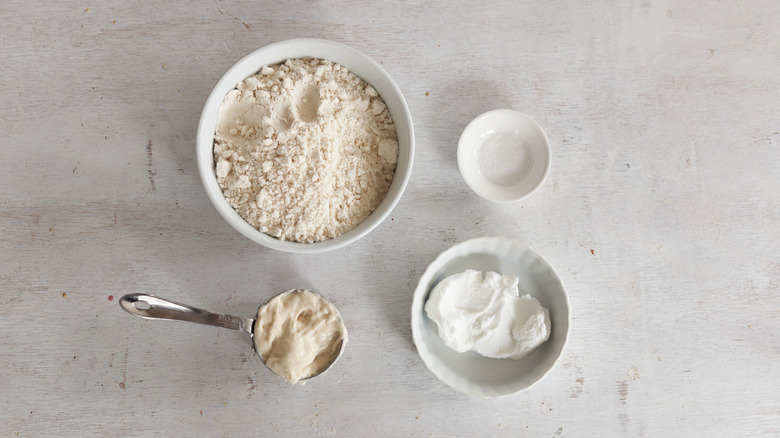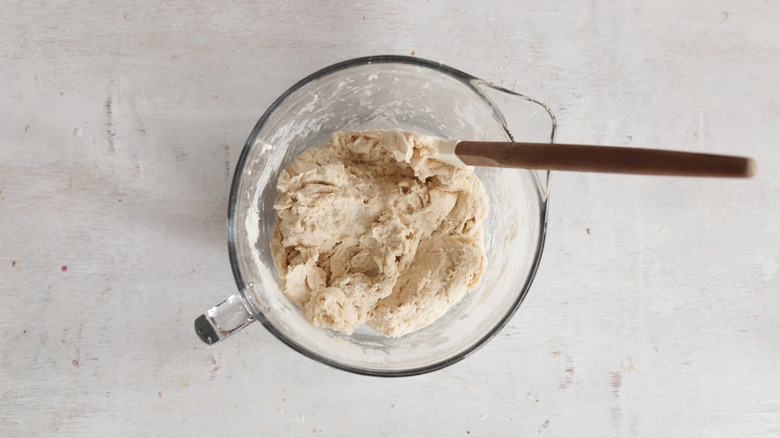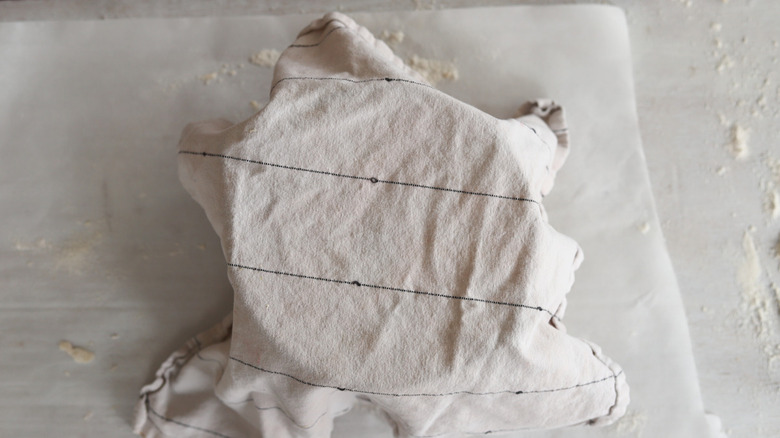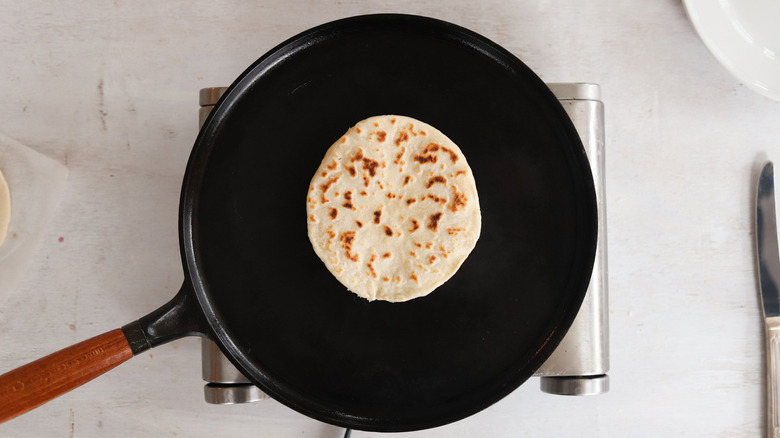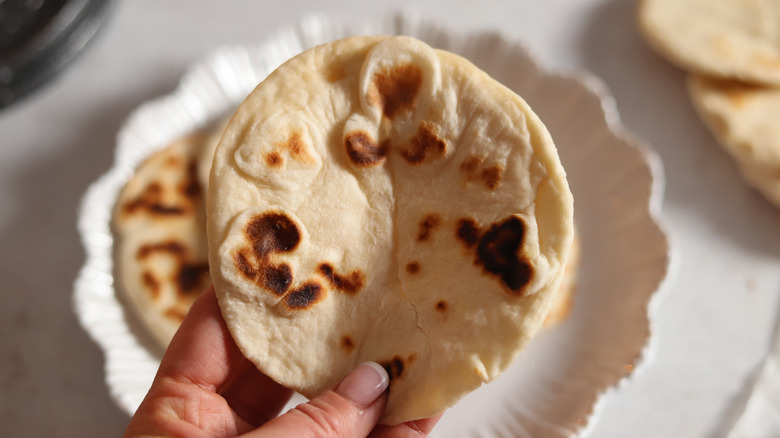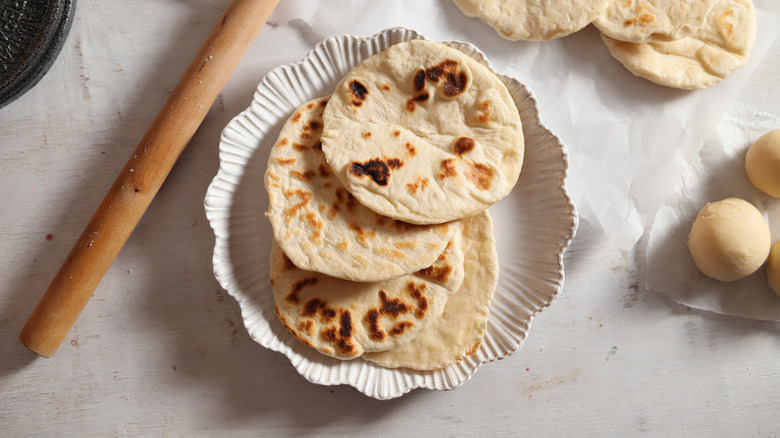Light And Fluffy Sourdough Tortilla Recipe
While many recipes in Mexican cuisine start with store-bought tortillas, it's actually not all that difficult to make them from scratch. While this recipe for homemade tortillas does take some time and elbow grease to make, developer Leah Maroney feels that the effort is well worth it, describing the finished product as "super soft and fluffy," adding, "They also taste less processed and have a much fresher flavor." Another way that these tortillas stand out from the kind you might buy in the supermarket is the fact that Maroney makes them with sourdough starter, which is something you can either buy or make yourself.
While you do not need to refrigerate your tortillas, Maroney notes that they will last for up to 1 week if you do. At room temperature, though, they are likely to go stale within 3 days. If you don't think you'll be using them up within either time frame, flour tortillas can be frozen for later use.
Collect the ingredients for the light and fluffy sourdough tortillas
While homemade flour tortillas are traditionally made with lard, this recipe substitutes in vegetable shortening, which makes it safe for vegan consumption. The only other ingredients you'll need are salt, all-purpose flour, and the aforementioned sourdough starter. If you'd like to try making your own, here's a foolproof sourdough starter recipe.
Step 1: Mix the first 3 ingredients with water
Combine ½ cup water with the shortening, salt, and sourdough starter in a large bowl. Mix until incorporated.
Step 2: Stir in the flour
Add the flour and mix until no flour pockets remain.
Step 3: Knead the tortilla dough
Knead the dough, adding flour as needed, until a smooth ball forms, about 5 minutes.
Step 4: Rest the tortilla dough
Cover the dough in a clean bowl and let it rest for 30 minutes.
Step 5: Roll the dough into balls
Divide the dough into 2-ounce balls, approximately 20 total. Cover, and let the dough balls rest for another 20 minutes.
Step 6: Flatten the dough balls
Press each ball in a tortilla press until completely flattened.
Step 7: Heat a pan
Preheat a griddle or flat pan on medium-high heat.
Step 8: Begin cooking the tortillas
Add 1 tortilla at a time and cook for 1–2 minutes.
Step 9: Finish cooking the tortillas
Flip and cook for an additional 1 minute. Repeat with the remaining tortilla dough.
Step 10: Put the tortillas to good use
Serve with your favorite taco fillings.
What are the origins and uses of the flour tortilla?
While corn tortillas date back to pre-Columbian times, flour tortillas may be a more recent invention. One possible origin story relates that they may have been an adaptation made by Jewish expatriates from Spain arriving in what is now North and South America — they preferred using imported wheat to native corn since the latter wasn't considered kosher. However, it's also to be noted that the Berbers and Moors, who occupied the Iberian Peninsula from the 8th to the 15th century, also made a type of flatbread from both wheat and chickpea flour.
We'd never presume to say that one kind of tortilla was better than the other, and that's because each of them is best for certain applications. Corn tortillas are typically used for tacos and are also the basis for tortilla chips. Flour tortillas, on the other hand, are better for wrap sandwiches since they tend to be more flexible and roll up better. They're also sturdy enough to hold all of the fillings in a burrito, and Maroney also notes that, when used for fajitas, "they soak up the juices super well," and these homemade sourdough tortillas make exceptional quesadillas.
How can I add different flavors to my flour tortillas?
There are several ways to add additional flavor to these homemade tortillas. Maroney tells us, "I would make spinach- or any other herb–flavored tortilla" and explains that in the former case, you would thaw a package of frozen spinach, then drain and puree it. You could also wilt and puree fresh spinach. Mix the spinach into the dough, adding flour as necessary to compensate for the excess moisture. Soaked, reconstituted sun-dried tomatoes, roasted garlic, or jalapeños can also be pureed and stirred into the dough, although you'll again need to add extra flour until it reaches the proper consistency.
As for the herbs, you can either add chopped fresh ones or go with the dried kind, while other possible dry additions include Parmesan cheese, garlic powder, and cayenne pepper. With these mix-ins, you shouldn't need to alter the basic recipe much, if at all.
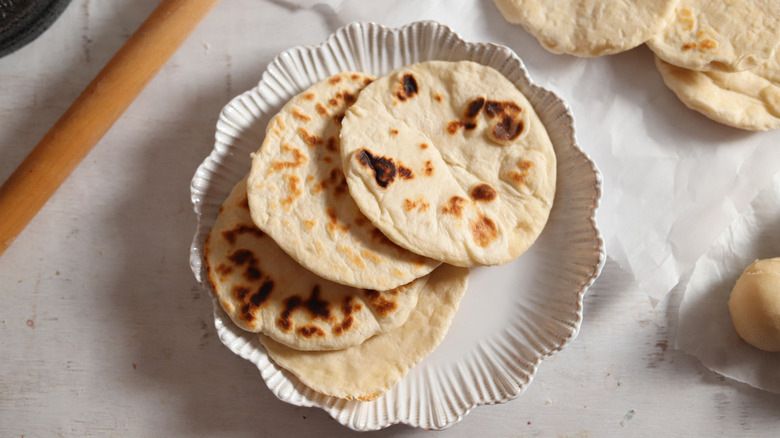
- ¼ cup vegetable shortening
- 2 teaspoons salt
- ⅔ cup sourdough starter
- 4 cups all-purpose flour
- Combine ½ cup water with the shortening, salt, and sourdough starter in a large bowl. Mix until incorporated.
- Add the flour and mix until no flour pockets remain.
- Knead the dough, adding flour as needed, until a smooth ball forms, about 5 minutes.
- Cover the dough in a clean bowl and let it rest for 30 minutes.
- Divide the dough into 2-ounce balls, approximately 20 total. Cover, and let the dough balls rest for another 20 minutes.
- Press each ball in a tortilla press until completely flattened.
- Preheat a griddle or flat pan on medium-high heat.
- Add 1 tortilla at a time and cook for 1–2 minutes.
- Flip and cook for an additional 1 minute. Repeat with the remaining tortilla dough.
- Serve with your favorite taco fillings.
| Calories per Serving | 117 |
| Total Fat | 2.8 g |
| Saturated Fat | 0.7 g |
| Trans Fat | 0.3 g |
| Cholesterol | 0.0 mg |
| Total Carbohydrates | 19.7 g |
| Dietary Fiber | 0.7 g |
| Total Sugars | 0.1 g |
| Sodium | 66.8 mg |
| Protein | 2.7 g |

